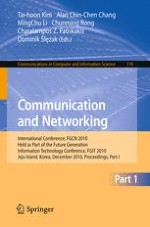Welcome to the proceedings of the 2010 International Conference on Future Gene- tion Communication and Networking (FGCN 2010) – one of the partnering events of the Second International Mega-Conference on Future Generation Information Te- nology (FGIT 2010). FGCN brings together researchers from academia and industry as well as practit- ners to share ideas, problems and solutions relating to the multifaceted aspects of communication and networking, including their links to computational sciences, mathematics and information technology. In total, 1,630 papers were submitted to FGIT 2010 from 30 countries, which - cludes 228 papers submitted to the FGCN 2010 Regular Sessions. The submitted papers went through a rigorous reviewing process: 395 of the 1,630 papers were - cepted for FGIT 2010, while 45 papers were accepted the FGCN 2010 Regular S- sions. Of the 45 papers, 8 were selected for the special FGIT 2010 volume published by Springer in LNCS series. 29 papers are published in this volume, and 8 papers were withdrawn due to technical reasons. We would like to acknowledge the great effort of the FGCN 2010 International Advisory Board and members of the International Program Committee, as well as all the organizations and individuals who supported the idea of publishing this volume of proceedings, including SERSC and Springer. Also, the success of the conference would not have been possible without the huge support from our Sponsors and the work of the Chairs and Organizing Committee.
